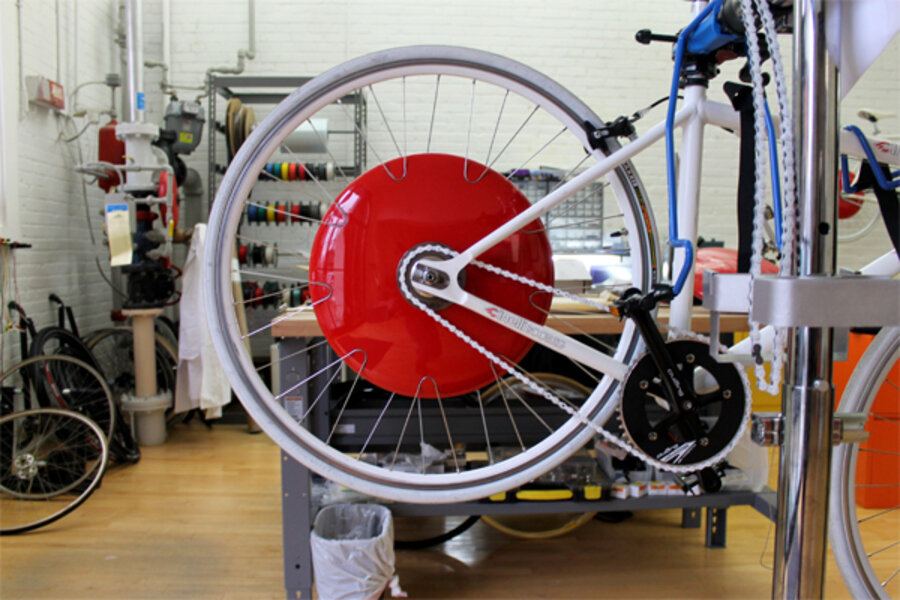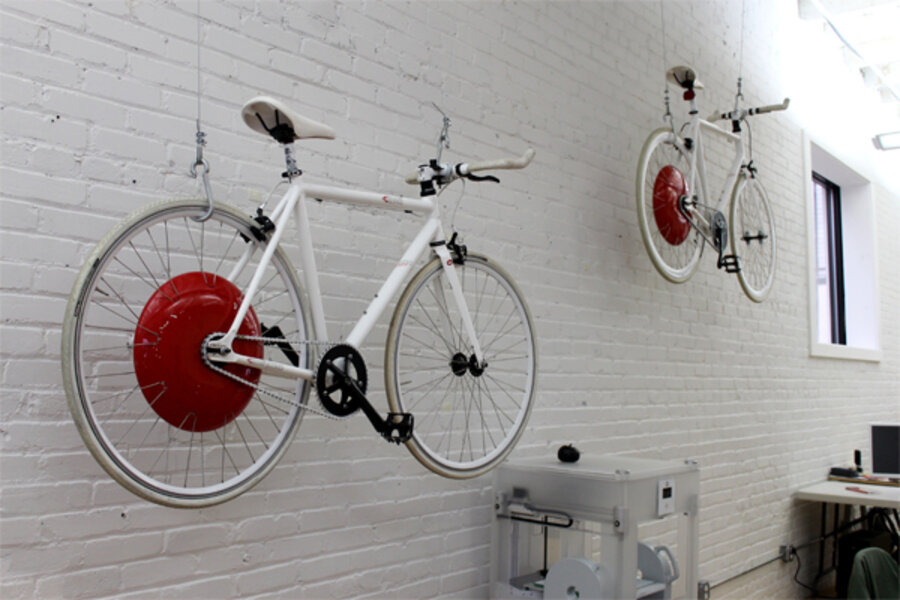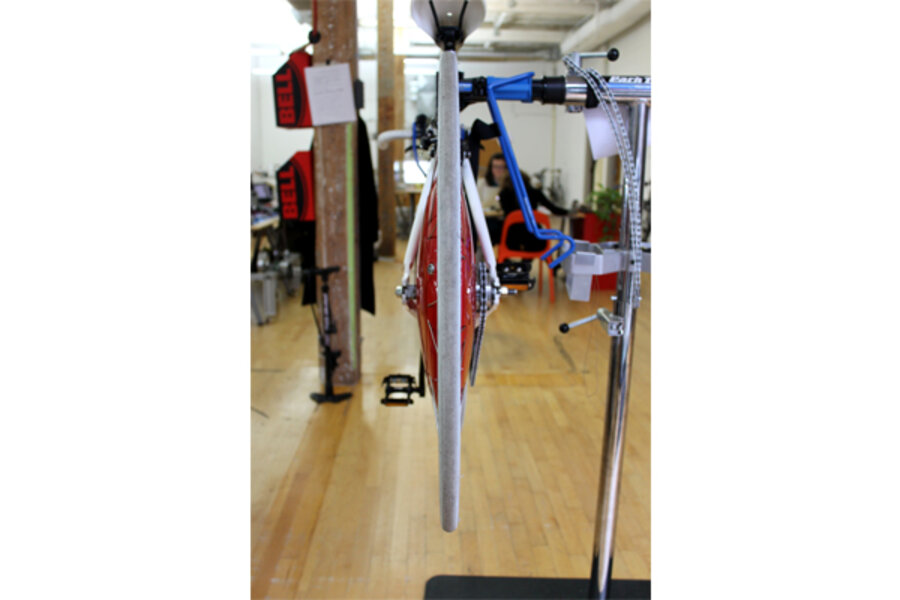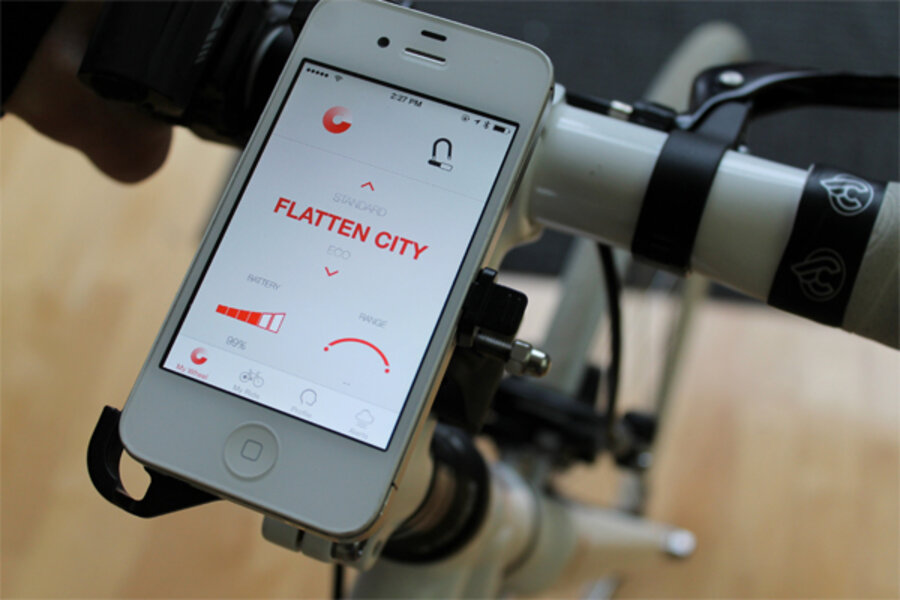Copenhagen Wheel zooms toward e-bike future
Loading...
| Cambridge, Mass.
A freezing mist gathered in small droplets on my fingers, tightly wrapped around the handlebars of a white bike. The first “snow” of December (which by that time had turned to rain) may not seem like the ideal time for a ride, but this wasn’t any ordinary bike – this was the Copenhagen Wheel.
I looked down at the iPhone attached to the handlebar between my shivering knuckles, where the Wheel’s app was open, displaying my metrics. Current speed was 0 miles per hour, battery level was nearly full, and mode was Turbo. I was ready to go.
"How fast could Turbo really be?" I thought as I pushed off for my first ride with the newest hybrid e-bike on the market.
Turns out, really fast. With one push, the Wheel turned me into the bicycling Hulk, the power of my legs magnifying with every pedal push. As I rounded a corner, my speed accelerated to 15 m.p.h. in what felt like seconds.
The Copenhagen Wheel started as a concept by the Massachusetts Institute of Technology’s (MIT) SENSEable City Lab in 2009 when the city of Copenhagen asked the lab to come up with a way to make biking more accessible to people in urban areas. MIT’s idea? Put a lightweight motor on a wheel that gleans energy from braking and coasting. After four years of development, the Copenhagen Wheel has been released by MIT start-up Superpedestrian, right as experts forecast the e-bike industry will grow faster than ever before.
“We realized people are rethinking bikes are a whole,” says Assaf Biderman, co-inventor of the Copenhagen Wheel. “We said 'Let’s let people keep their bike, but [change] where the value lies.'”
The value is now in the wheel – specifically, the 12-pound, cherry-red motor placed like a hubcap in the middle of the back wheel.
As opposed to an e-bike, the Copenhagen Wheel is an e-wheel – meaning you can add the technology to any bike you choose. The device is powered by regenerative braking, transforming the kinetic energy used to slow a rider's speed into stored power. In other words, when you brake or go downhill, the battery recharges, allowing you to rely on the bike’s power for up to 30 miles at up to 20 m.p.h. It operates on a 350-watt electric motor with a 48-volt lithium-ion battery, which can offer an energy output of more than four times the average bike rider.
The Wheel can be controlled by an app that lets you decide how much you want to work. Pedal options range from Turbo, which uses the most energy, to Flatten Cities, which kicks in on an incline, to Eco, which adds a small push when your natural pedaling seems to slow. The app measures distance traveled, calories burned, and elevation climbed, which are all shareable on social media.
“The motor really integrates to your body; if you want to sweat, you can sweat,” Mr. Biderman says. “You have a choice. You can choose to live in the suburbs and ride 10 to 15 miles and make it to work without a sweat.”
Sweating and distance are exactly what has driven many toward e-biking technology, according to Jennifer Dill, professor at the Nohad A. Toulan School of Urban Studies and Planning at Portland State University in Portland, Ore. Ms. Dill, along with fellow Portland State researcher John MacArthur, recently completed a survey monitoring the habits and motivations of e-bikers across the country.
The survey found that 34 percent of e-bike riders say they ride to places further away once they had an e-bike, with another third saying they also use the e-bike to run errands or get to social events – both instances where distance and perspiration could play a role.
“The e-bike takes a little less effort to ride,” she says. “Anyone who has any physical impairments ... an e-bike can help with that.” Her survey showed 45 percent of e-bike commuters are over the age of 55.
She also points out that 60 percent of respondents feel safer while riding an e-bike than a standard bike. And with an e-wheel – like the Copenhagen Wheel –riders can get the extra push of an e-bike, but still pedal like a normal bike. There's no twisting a throttle or revving an engine. To unknowing eyes, a bike with the Copenhagen Wheel looks like any other, save the funky red wheel. Subtlety was a key aspect of the design, says Biderman.
“If you put a battery and controller on the bike, and you have to wire up your bike, it looks awful ... and requires expert installation,” he says. Biderman claims the wheel can be put on a bike in five minutes if you’ve never seen a bike before – 30 seconds if you’re a bike pro.
Outside of the United States, e-bikes are already common. According to Quartz, 200 million e-bikes have been sold in China. In Europe, e-bike sales increased from 100,000 in 2006 to about 850,000 in 2012. Navigant Research, a clean technology research group, predicts that e-bike sales will increase 23 percent worldwide by 2020, becoming a $38 million industry. The US, however, will only see an increase of about 9 percent over the same period.
While e-bikes take off, e-wheels have recently become more visible: The Copenhagen Wheel made headlines when it garnered $2.1 million in investments in October. Bike company FlyKly raised more than $700,000 on Kickstarter to produce an e-wheel that will be released next spring. And Italian company Zehus says it will release a hybrid e-bike with a smart wheel in 2014.
Regardless, the road to an e-bike future is far from fruition. Convoluted US bike laws have led many to wonder “is my e-bike legal?” Full e-bike prices are steep, often more than $1,000. E-wheels address some of the cost issues, but are pricey compared with an average bike: the Copenhagen Wheel retails for $699, and will bump to $799 after the first batch sells out. FlyKly is aiming for $500; ZeHus has yet to announce a price.
But for one soggy reporter out for a test drive, a smart wheel was starting to feel like a smart choice. Toward the end of my ride, I got a bit lost in a maze of one-way streets in the industrial corner of Cambridge where Superpedestrian is located.
Once I got my bearings, however, I was relieved not only to know where I was, but that I wouldn’t have to work too hard to get back. I switched the Wheel to Turbo, and zoomed off in the right direction.









